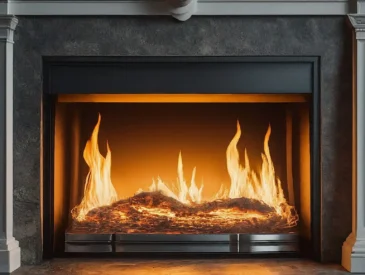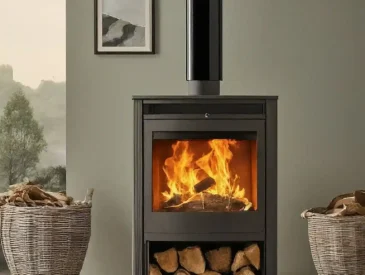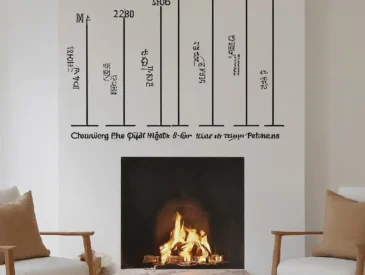A fireplace mantel not only adds a touch of elegance to your hearth but also serves as a space for creative decoration. However, it’s essential to understand how hot a fireplace mantel can get to ensure safety.
A typical fireplace mantel can withstand temperatures of about 185 degrees Fahrenheit. When in use, the mantel’s temperature should ideally stay below 185 degrees, around 100 degrees Fahrenheit, which is warm to the touch.
While most mantels are designed to be safe, it’s crucial to be aware of their heat tolerance, especially when decorating them with potentially flammable items. This article delves into the temperature limits of mantels and offers tips on safeguarding them from excess heat.
How Hot Can a Fireplace Mantel Get?
A fireplace mantel is engineered to endure temperatures up to 117 degrees Fahrenheit above room temperature, which translates to around 185 degrees Fahrenheit, give or take. The material of the mantel also affects its heat resistance, with stone mantels being more heat-resistant compared to wood mantels.
The mantel forms part of the fireplace surround, acting as a top shelf. While it’s the most protected part from direct heat, it can still warm up enough to be felt as hot to the touch.
It’s worth noting that something becomes hot to touch at approximately 150 degrees Fahrenheit, though most materials warm up before reaching that point. Room temperature typically hovers around 68 degrees Fahrenheit.
Fortunately, mantels seldom become overly hot unless the fireplace is improperly installed. This is evident in the fact that mantels can be made from wood, a combustible material unsuitable for other parts of a fireplace. Despite some warming, mantels maintain a temperature conducive to decoration. However, it’s wise to exercise caution, especially with combustible decorations, opting for items like candles or mirrors instead.
Can a Fireplace Mantel Overheat?
A properly installed fireplace usually doesn’t generate excessive heat to make the mantel too hot to touch. However, if a fireplace is incorrectly installed, excessive heat can accumulate within the firebox, causing the mantel and surround to become dangerously hot.
Flue issues can also lead to an overheated mantel, as trapped heat has no way to dissipate. Additionally, a mantel positioned too close to the firebox can result in overheating.
The standard clearance for a mantel is at least 12 inches, ensuring an adequate gap between the firebox and the mantel. Any less space could pose a fire hazard. The closer the mantel is to the firebox, the warmer it will become.
Different Fireplace Types and Mantel Heat Levels:
1. Electric Fireplaces:
Electric fireplaces typically emit around 5000 BTUs, enough to heat a room of approximately 400 square feet. These fireplaces don’t produce an actual flame and operate much like a standard room heater. Consequently, they do not generate enough heat to risk overheating the mantel.
2. Gas Fireplaces:
Gas fireplaces can reach temperatures as high as 1000 degrees Fahrenheit inside the firebox. However, these fires are meticulously controlled and generally safe. Properly installed gas fireplaces should not cause the mantel to overheat.
3. Wood-Burning Fireplaces:
The temperature output of wood-burning fireplaces can vary based on factors like the type of wood burned and the fire’s size. Hardwoods burn slower, creating a hotter fire.
While wood-burning fireplaces can generate more heat, a correctly installed fireplace will not overheat the mantel. Nevertheless, it’s advisable to monitor the mantel’s temperature, particularly when burning hardwoods or creating large fires.
How to Safeguard Your Fireplace Mantel from Excessive Heat:
1. Ensure the Flue Is Open:
Before making any significant adjustments, confirm that the flue is open. The flue serves as the passageway for air from the fireplace to the outdoors. If closed, the trapped hot air can cause surrounding areas to become excessively warm.
2. Consider a Fireplace Blower:
Installing a fireplace blower aids in circulating heat throughout the room, diverting hot air away from the fireplace. This helps prevent the mantel from overheating.
Fireplace Mantels; How Hot Do They Get (Per Fireplace Type)
A fireplace mantel is a stunning piece that finishes the look of any fireplace. It’s also a common spot for homeowners to decorate, but how hot does a fireplace mantel get?
A fireplace mantel can withstand temperatures of up to about 185 degrees Fahrenheit. When lighting your fireplace, the temperature of the mantel should ideally be below 185 degrees, typically around 100 degrees Fahrenheit. This is warm to the touch and safe for decorative items.
Mantels are often used as decorative shelves, so it’s crucial to understand their heat resistance before decorating them with potentially combustible objects.
In most cases, mantels are safe, but it’s essential to be aware of their temperature limits. This article explores the temperatures a mantel can reach and offers tips on safeguarding it from excessive heat.
How Hot Does A Fireplace Mantel Get?
A fireplace mantel is designed to withstand temperatures approximately 117 degrees Fahrenheit above room temperature. This translates to a maximum of around 185 degrees Fahrenheit, give or take.
The material your mantel is made of plays a role in its heat resistance, with stone mantels being more heat-resistant than wood mantels.
The mantel is the top part of the fireplace surround and is often used as a decorative shelf. While the mantel is the part most protected from heat, it can still become warm, occasionally reaching a point where it may feel hot to the touch.
An object becomes very hot to the touch at around 150 degrees Fahrenheit, but most materials are warm to the touch even before reaching that temperature. Room temperature is generally around 68 degrees Fahrenheit.
Fortunately, a mantel typically never gets excessively hot unless the fireplace is installed incorrectly. This is evident from the fact that mantels can be made of wood, a combustible material that cannot be used for other parts of a fireplace.
Despite the slight warming of mantels, they usually stay at a temperature that allows for decorations, such as candles or mirrors. While it’s a good practice to exercise caution with combustible materials, a well-protected mantel is generally safe for decorating.
Can A Fireplace mantle get Too Hot?
A mantel does not typically become too hot unless there is a problem with the fireplace installation. Excessive heat buildup within the firebox, due to issues like flue problems or improper mantel placement, can cause the mantel to become excessively hot.
The standard clearance for a mantel is a minimum of 12 inches, meaning there should be at least a 12-inch gap between the firebox and the mantel. Any less space can pose a fire hazard because the mantel is too close to the actual fire source.
The type of fireplace also matters:
1. Electric Fireplaces: Electric fireplaces, which do not have an actual flame and function like room heaters, typically emit around 5000 BTUs. This is sufficient to heat a room of about 400 square feet but not enough to overheat a mantel.
2. Gas Fireplaces: Gas fireplaces can reach temperatures as high as 1000 degrees Fahrenheit inside the firebox. However, the mantel remains generally safe from overheating, as gas fires are highly controlled and safe, provided there are no installation issues.
3. Wood-Burning Fireplaces: Wood-burning fireplaces can vary in temperature output depending on the type of wood burned and the size of the fire. In general, just like other fireplace types,
a wood-burning fireplace does not overheat a mantel as long as everything is installed correctly. However, the temperature can vary depending on the type of wood used. Some common woods used in wood-burning fireplaces and their respective burning temperatures are:

Ash, Elm, Beech, and Hornbeam: Burn at around 1832 degrees Fahrenheit.
Birch, Larch, and Oak: Burn at around 1652 degrees Fahrenheit.
Pine, Redwood, and Spruce: Burn at around 1157 degrees Fahrenheit.
Hardwoods tend to burn more slowly, creating a hotter fire. While the fire may be hotter, a well-installed wood-burning fireplace typically does not overheat the mantel. However, it’s a good practice to monitor the mantel if you burn hardwoods or create a large fire.
How Do I Protect My Fireplace Mantel From Heat?
If your fireplace mantel becomes too hot, consider the following measures:
1. Ensure the Flue Is Open: Before making any significant changes, check if the flue, the airway from your fireplace to the outside, is open. A closed flue can trap heat inside the firebox, causing the surrounding areas to heat up. Ensure the flue is open to allow heat and smoke to escape safely.
2. Install a Fireplace Blower: A fireplace blower helps circulate heat around your room by blowing hot air away from the fireplace. This also prevents the mantel from overheating.
3. Use a Heat Shield: A heat shield, typically made of reflective material, can be installed on the wall above the mantel to protect it from excess heat. The shield reflects heat away from the mantel and safeguards it from potential damage.
4. Relocate Combustible Items: Ensure that any combustible objects or decorations are placed at a safe distance from the mantel. Maintain a clearance of at least 12 inches between the firebox and the mantel to prevent the risk of fire.
By taking these precautions, you can enjoy your fireplace mantel as a beautiful decorative element without compromising safety.
It’s essential to maintain proper installation and use of your fireplace to ensure the mantel remains at a safe temperature for decorating.





